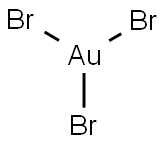Chemical Properties
Yellowish-gray mass. Decomposes at
approximately 165C. Insoluble in water.
Uses
Analysis (testing for alkaloids, spermatic fluid),
medicine.
Uses
Gold(III) bromide is used as a catalyst in a variety of reactions. It catalyzes the reaction between an enynal unit and carbonyl compounds to form a six-membered cyclic compound. Another catalytic use of gold tribromide is in the nucleophilic substitution reaction of propargylic alcohols, with the gold complex acting as an alcohol-activating agent to facilitate the substitution. It can be used as a testing reagent for the presence of ketamine.
Definition
Brownish-black powder. Mp 160C with decomposition. Soluble in water and alcohol.
reaction suitability
reagent type: catalyst
core: gold
Purification Methods
Purify it by adding pure Br2 to the dark powder, securely stopper the container, warm a little and shake while keeping away from light for ca 48hours. Remove the stopper and place it over NaOH until free Br2 is no longer in the apparatus (48-60hours). The bright yellow needles of the tribromide are stable over NaOH in the dark. It is soluble in H2O and in EtOH where it is slowly reduced. Keep it in a cooled, closed container and protect it from light as decomposition causes free gold to be formed. Aurobromic acid can be obtained by adding the calculated amount of conc HBr to AuBr3 (actually Au2Br6) until all dissolves, whereby the acid crystallises out as HAuBr4.5H2O; a deliquescent solid soluble in EtOH with m ca 27o, and store it as above. [Gibson & Colles J Chem Soc 2411 1931, Burawoy & Gibson J Chem Soc 217 1935, Burawoy & Gibson J Chem Soc 219 1935.]

